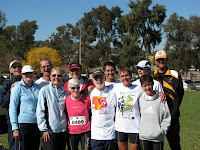2009 is almost over. For me it's been a year of happiness and sadness; of Yin and yang; of pleasure and pain; of fast and slow. In short, the year has been just like running.
December 16 was the saddest day. After returning from a run with the Wednesday group I received a phone call from my sister Jane. Dad had passed away — he finally succumbed to complications following heart valve surgery. His passing came as something of a shock, as he had seemed to be rallying after many weeks of intensive care. He was 84.
I ran my first marathon with Dad back in '81. It was also his first. We completed our weekend long runs together on quiet roads through the flat farmlands south-east of Wagga. On other days Dad would sometimes accompany me on his Malvern Star 10-speed and urge me to run at 14 or 15 kilometres per hour. I think he was impressed with such running speeds because at age 55 they were beyond him. They are now beyond me! In the marathon I ran 3:41, and Dad 4:38. Both our marathon careers soon stalled, although not before Dad had improved his PB to (I think) 4:10. He took up competitive kayaking while continuing with sailing and 'fun running'. He completed many City-to-Surfs during the 1980s and early '90s. I gave away marathoning in a quest to improve at shorter races.
The funeral was on December 22 near Chinderah in northern NSW. I arrived on a flight from Sydney and Jane from Tasmania via Melbourne. My brother rented a holiday unit near Coolangatta beach for a few days. It was great to spend time with him, Catriona and the kids — Nathan and Claire, now teenagers — how fast they've grown! Also, a rare meeting with some of the cousins — Mike, Col, Jan, Wendy (Granny Lulu), Rob, and Rob's wife Sherry. We don't see them very often, so enjoyed their company in spite of the circumstances.
Anyway friends, back to running — which I guess this blog should be about. In terms of Yin and yang, the year was a failure — although not as disastrous as the year experienced by Julie. I wanted to run 11:39 for 3000 metres, but could only manage 12:26. Are times that important? Yes. And no. Enjoying racing and training is important to me, and I had fun with both. It was also my good fortune to meet some new friends, while trying to keep up with the old ones — they all run so fast! Here's to more of the same in 2010, and here's to you too — may you enjoy a year of happy and successful running.
December 16 was the saddest day. After returning from a run with the Wednesday group I received a phone call from my sister Jane. Dad had passed away — he finally succumbed to complications following heart valve surgery. His passing came as something of a shock, as he had seemed to be rallying after many weeks of intensive care. He was 84.
I ran my first marathon with Dad back in '81. It was also his first. We completed our weekend long runs together on quiet roads through the flat farmlands south-east of Wagga. On other days Dad would sometimes accompany me on his Malvern Star 10-speed and urge me to run at 14 or 15 kilometres per hour. I think he was impressed with such running speeds because at age 55 they were beyond him. They are now beyond me! In the marathon I ran 3:41, and Dad 4:38. Both our marathon careers soon stalled, although not before Dad had improved his PB to (I think) 4:10. He took up competitive kayaking while continuing with sailing and 'fun running'. He completed many City-to-Surfs during the 1980s and early '90s. I gave away marathoning in a quest to improve at shorter races.
The funeral was on December 22 near Chinderah in northern NSW. I arrived on a flight from Sydney and Jane from Tasmania via Melbourne. My brother rented a holiday unit near Coolangatta beach for a few days. It was great to spend time with him, Catriona and the kids — Nathan and Claire, now teenagers — how fast they've grown! Also, a rare meeting with some of the cousins — Mike, Col, Jan, Wendy (Granny Lulu), Rob, and Rob's wife Sherry. We don't see them very often, so enjoyed their company in spite of the circumstances.
Anyway friends, back to running — which I guess this blog should be about. In terms of Yin and yang, the year was a failure — although not as disastrous as the year experienced by Julie. I wanted to run 11:39 for 3000 metres, but could only manage 12:26. Are times that important? Yes. And no. Enjoying racing and training is important to me, and I had fun with both. It was also my good fortune to meet some new friends, while trying to keep up with the old ones — they all run so fast! Here's to more of the same in 2010, and here's to you too — may you enjoy a year of happy and successful running.









![Into the wind [photo by D Appleby] Into the wind [photo by D Appleby]](https://blogger.googleusercontent.com/img/b/R29vZ2xl/AVvXsEi5Fu3qElWUG_GJ-zFzwTGs4hWz_8W2WpCGqpmOn7nPmWfFMg89ZXGiI_NUJwLfKcRJ2c6-6Gd_WqmH7A0q_g3OynjY2ac0F2TgwPoHJ1-sys5L7xFW1vH1ROY6nYTtJMWpkBZmUQ/s200/ewen_skijump.jpg)

















